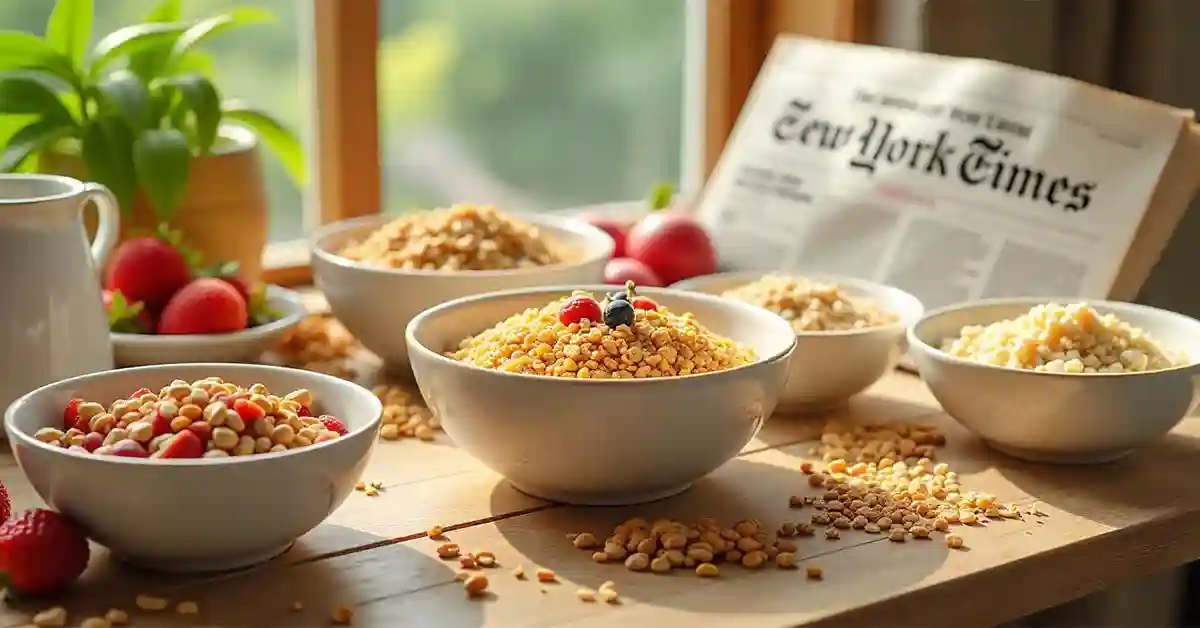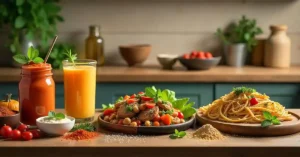In today’s fast-paced world, people are looking for nutritious options to start their day. Ancient grains in a healthy cereal offer just that—providing essential nutrients and flavorsome taste. These grains, like quinoa, spelt, and amaranth, have been cherished for centuries. Why are they making a comeback now? This article will explore the importance of ancient grains for modern diets, examining their nutritional benefits and versatile uses in cereals.
What makes ancient grains so special in a world full of processed foods? Ancient grains are less refined, meaning they retain more nutrients than their modern counterparts. They are high in fiber, protein, and essential vitamins and minerals. Could incorporating these grains into your breakfast boost your overall health? Stay tuned as we answer this and more.
Adding them to your diet can lead to numerous health benefits, like improved digestion and increased energy levels. For those seeking healthier meal options, ancient grains offer a delicious and beneficial choice. Read on to learn how you can transform your breakfast into a powerhouse of nutrition.
The Rise of Ancient Grains
Ancient grains have been part of human diets for thousands of years. They were consumed by early civilizations like the Aztecs and the Incas. Today, these grains are gaining popularity among health-conscious individuals. But why now? The push for whole foods and natural ingredients has led people to seek traditional food sources.
These grains are unaltered by modern agricultural techniques. Unlike wheat and corn, which have been heavily hybridized, ancient grains remain pure. They’re considered more nutritious as they haven’t lost their natural goodness over time. With their unique flavors and textures, they bring something fresh to the table.
Incorporating these grains into your cereal offers a variety of health benefits. From increasing fiber intake to providing essential amino acids, ancient grains are a nutritional powerhouse. They also contain antioxidants and other compounds that contribute to overall well-being. Incorporating them into meals can enhance both taste and health.
What Are Ancient Grains?
Ancient grains are seeds or cereals that have not changed much in the last few hundred years. These include quinoa, farro, spelt, amaranth, and millet. They are often considered more nutritious than modern grains. This is because they are less refined and have more nutrients.
Unlike processed grains, ancient grains retain their bran and germ. This means they have more fiber, vitamins, and minerals. Their natural goodness contributes to balanced nutrition. They are versatile and can be used in various recipes—from bread to salads.
Their rich flavors and textures make them a preferred choice for many. Ancient grains are appreciated for their health benefits and culinary possibilities. Choosing them over refined grains can enhance your diet and improve your health.
Nutritional Powerhouse
Ancient grains provide a wealth of nutrients that are vital for good health. They are high in fiber, which promotes healthy digestion. Fiber helps prevent constipation and regulates blood sugar levels. It also aids in maintaining a healthy weight by making you feel full longer.
These grains are also rich in protein, making them a great option for vegetarians and vegans. Protein is essential for building and repairing tissues in the body. It also supports muscle mass and overall strength. Consuming enough protein is crucial for energy and vitality.
In addition to fiber and protein, ancient grains contain essential vitamins and minerals. These include B vitamins, iron, magnesium, and zinc. These nutrients play important roles in the body, supporting everything from metabolism to immune function.
Health Benefits
The health benefits of ancient grains are numerous. One major advantage is their ability to support heart health. Many ancient grains are rich in antioxidants, which help fight inflammation. Inflammation is linked to heart disease, so consuming these grains can be beneficial.
Another benefit is improved digestive health. The high fiber content in ancient grains aids digestion by promoting regular bowel movements. It also helps maintain a healthy gut microbiome, which is essential for overall well-being.
Additionally, these grains can boost energy levels. They provide complex carbohydrates, which are a steady source of energy. Unlike simple sugars, complex carbs do not cause blood sugar spikes. This means sustained energy throughout the day.
Versatile Uses in Breakfast Cereals
One of the best ways to enjoy ancient grains is by incorporating them into breakfast cereals. They can be added to homemade granola or oatmeal for a nutritious start to the day. Their rich textures enhance the flavor profile of your meals.
These grains can also be used to make pancakes, waffles, or muffins. Their natural sweetness adds depth to baked goods. You can even mix them with nuts and dried fruits for a wholesome snack.
Whether cooked or raw, ancient grains offer endless possibilities. Their versatility makes them an excellent choice for those looking to diversify their meals. Experimenting with different combinations can lead to delightful discoveries.
How to Choose the Right Ancient Grains
Choosing the right ancient grains depends on personal preferences and dietary needs. Quinoa is a great option for those seeking a complete protein source. It’s gluten-free, making it suitable for people with celiac disease or gluten sensitivity.
Farro and spelt are excellent choices for those who enjoy hearty flavors. They are slightly chewy and have a nutty taste. These grains are perfect for making salads or pilafs.
Amaranth and millet are ideal for porridge-like dishes. They have a mild flavor and can be cooked until creamy. These grains are often used in breakfast bowls or soups.
Cooking Tips for Ancient Grains
Cooking ancient grains is simple and straightforward. Rinse them under cold water to remove any dust or debris. This step is essential for grains like quinoa, which have a natural coating called saponin. Saponin can taste bitter if not rinsed off.
Use a 2:1 ratio of water to grains for most varieties. Bring the water to a boil, then reduce the heat to a simmer. Cover the pot and cook until the grains are tender and the water is absorbed.
Experiment with adding herbs, spices, or broth to the cooking liquid. This enhances the flavor of the grains. Once cooked, fluff them with a fork and enjoy.
Incorporating Ancient Grains into Your Diet
Incorporating ancient grains into your diet is easy. Start by replacing refined grains with ancient ones in your favorite recipes. Swap white rice for quinoa or millet. Use spelt or farro in soups and stews.
Try adding ancient grains to salads for added texture and nutrition. They pair well with vegetables, beans, and healthy fats like avocado. This combination creates a satisfying meal that’s rich in nutrients.
For breakfast, consider mixing them into yogurt or smoothies. This adds a nutritional boost to your morning routine. Ancient grains can be enjoyed in countless ways, making them a versatile addition to any diet.
The Importance of Variety
Including a variety of ancient grains in your diet ensures a broad range of nutrients. Each grain offers unique health benefits. By consuming different types, you maximize your nutritional intake.
Rotating between grains like quinoa, amaranth, and spelt prevents dietary monotony. It also allows you to experience diverse flavors and textures. This keeps meals exciting and enjoyable.
Variety is key to a balanced diet. Incorporating different ancient grains helps achieve this balance. Experimenting with new recipes and combinations can make healthy eating fun.
Ancient Grains and Sustainability
Ancient grains are not only nutritious but also environmentally friendly. They are often grown using sustainable farming practices. These practices protect the soil and reduce the need for chemical inputs.
Many ancient grains are drought-resistant, requiring less water to grow. This is important for preserving natural resources. Choosing these grains supports agricultural sustainability.
By incorporating ancient grains into your diet, you’re making a positive impact. Supporting sustainable agriculture benefits the planet and future generations. It’s a small change that can make a big difference.
FAQs With Answers
What are ancient grains?
Ancient grains are seeds or cereals that have remained unchanged for hundreds of years. They include quinoa, spelt, amaranth, and more. These grains are often more nutritious than modern grains.
Why are ancient grains healthier?
Ancient grains are less refined, retaining more nutrients. They contain fiber, protein, and essential vitamins and minerals. This makes them more nutritious than processed grains.
How can I use ancient grains in my diet?
Ancient grains can be used in various recipes, from breakfast cereals to salads. They are versatile and can replace refined grains in most dishes. Experiment with different combinations for added flavor.
Are ancient grains gluten-free?
Some ancient grains, like quinoa and amaranth, are gluten-free. Others, like spelt and farro, contain gluten. Choose grains based on your dietary needs and preferences.
Where can I buy ancient grains?
Ancient grains are available at most grocery stores and health food shops. They can also be purchased online from reputable retailers. Look for organic or sustainably sourced options when possible.
Conclusion
Incorporating ancient grains into your diet is a step towards better health and sustainability. These nutrient-rich grains offer a delicious way to enhance your meals. With their versatile uses and numerous benefits, they are truly a powerhouse of nutrition.
By choosing ancient grains, you support sustainable agriculture and contribute to environmental preservation. It’s a small change that can have a significant impact on your health and the planet. Explore the world of ancient grains and transform your meals into nourishing experiences.




